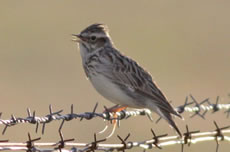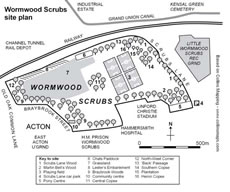Mammoth Skylark Count Marks Bitter Cold
Worries on Stonechats for Wormwood Scrubs birders
(From Newsletter sent by David Lindo)
Brrrrrrrr!
January 2010 will be remembered principally for the extreme wintry weather that we all experienced in Britain. It was bitterly cold for days on end and The Scrubs was under snow cover for prolonged periods. Classic cold weather movement was much in evidence with the numerous Redwings and Fieldfares being the most obvious signs. However, a mammoth count of 50 Skylarks during one morning session was a further indication of the severity of the weather conditions. Birds were literally scratching around for food and were often quite approachable.
Unlike many sites in London (and indeed the UK) we didn’t come across any wayward Woodcocks – despite searching. Although we did miss a trick, as this plump woodland wader is a night feeder and what we should have done was to have shown up after dark to see if any were feeding out on the open snow.
It was the best January on record when it came to the variety of species, the best bird being our returning Mediterranean Gull, but it was also a great opportunity to see some usually flighty species at fairly close quarters. More disturbing though was the apparent demise of our resident Stonechats. These insect eaters are particularly sensitive to cold winters and no doubt will have suffered tremendously across the country. We can only hope that our Stonechats managed to move to another area to find easier food and did not perish on our beloved patch.
Contributors: Rob Ayers, Mathew Bournat, David Jeffreys, David Lindo, Roy Nuttall, Anders Price et al.
Cormorant
A couple of birds were recorded during the month.
Grey Heron
The occasional singleton was reported with two separate birds noted on the 7th.
Canada Goose
Small numbers were noticed with 6 on the 25th being the most.
Kestrel
The pair watched displaying on the 24th were officially the first reported since October 2009.
Sparrowhawk
Only one bird was seen on the 26th.
Black-headed Gull
Due to the sometimes harsh conditions numbers of this common gull fluctuated quite a bit with most birds noticed overhead. Over 180 were counted on the 7th.
Mediterranean Gull
Our wintering adult made another appearance on the 18th on the football pitches having originally being discovered there in November last year.
Common Gull
At least 45 were overhead on the 7th and 60 appeared on the 21st.
Herring Gull
Quite a large count of c60 was seen on the 7th.
Lesser Black-back
Around 20 were counted on the 7th.
Great Black-back
This massive gull is quite a scarcity here as they are essentially more coastal than the other large gulls. A pair headed northwest over Lester’s Embankment on the 31st.
Woodpigeon
At least 100 were in the vicinity on the 7th.
Rose-ringed Parakeet
At least 400 birds left their Braybrook Street roost on the 7th.
Green Woodpecker
The bird seen on the 15th must have made a pretty sight as it flew across the snow-clad landscape. It or another was seen on the 27th and a bird was heard calling loudly from Scrubs Lane Wood on the 31st.
Great Spotted Woodpecker
A bird was seen on the 17th meanwhile a pair were watched cavorting together on the 27th.
Skylark
Our largest ever count of this decreasing farmland species occurred during the absolutely freezing morning of the 7th when at least 50 birds were seen. This number included around 20 birds that were roving around of which 11 were feeding on the snowy field north of the prison.
Thereafter, these larks were seen infrequently in ones and twos.
Meadow Pipit
The average count for this hardy little bird was around 10 but at least 20 were seen on the 7th and 15th.
Pied Wagtail
A few birds were reported through the month with 4 being the most on the 17th.
Wren
As in December, small numbers were noted with a maximum of 5 being the limit.
Dunnock
Very few were seen during January with 5 seen on the 17th perhaps the highest count.
Robin
Around 5 birds were seen along the northern edge of Scrubs Lane Wood and Chats Paddock on the 7th.
Song Thrush
Very small numbers were noted.
Redwing
Hungry flocks were readily seen especially during the freezing weather. Up to 40 birds were regularly sighted.
Fieldfare
Around 40 flew over on the 7th. When the snows came this active winter thrush along with their Redwing cousins became much more prevalent. At least 120 were around on the 15th with at least 100 feeding on the snow in the company of 20 Redwings.
Mistle Thrush
A singleton was seen on the 26th and a pair was on the grass together near the northwest corner the following day. This bold thrush is an early nester and in days of old was often referred to as the ‘Storm Cock’ due to its habit of singing from the exposed tops of trees in all weathers early in the year.
Blackbird
At least 20 were counted on the 7th.
Great Tit
Normally during the height of winter our smaller birds evaporate to more welcoming abodes like the plentiful neighbouring back gardens filled with tons of free food that’s often replenished on a daily basis. So 6 on the 7th was a big count.
Blue Tit
At least 10 birds were encountered on the 7th.
Long-tailed Tit
A small troop of 8 was noticed moving along Lester’s Embankment on the 7th and perhaps 10 were seen at the same location on the 31st.
Magpie
Around 20 birds were counted on the 7th.
Jackdaw
At least one bird was calling flying around Central Copse on the 31st.
Carrion Crow
There are certainly far less crows around than there used to be. In 2006 there were nearly double the 80 or so that were seen this month.
Starling
Around 40 were drifting around on the 7th and 31st.
House Sparrow
At least 12 were seen near Braybrook Street on the 26th.
Chaffinch
Although there were probably more around than met our eyes only 2 were seen on the 26th and around 5 on the 31st.
Greenfinch
Our winter population peaked at around 15 on the 7th. By the end of the month several males were displaying along Lester’s Embankment.
Linnet
The first returning birds appeared on the 26th when at least 2 birds were encountered.
Lesser Redpoll
On the 27th, 3 were discovered in a birch tree in Martin Bell’s Wood. The observer specifically identified them as Lesser Redpoll due to their brown appearance and small size. The other similar species is the Mealy Redpoll, which is marginally larger, colder brown looking and is far, far scarcer.
At least 5 unidentified Redpolls (probably Lesser) were flying around Central Copse on the 31st.
Goldfinch
A singer was heard on the 15th and around 8 were in Central Copse on the 31st.
Bullfinch
This beautiful finch is a bit of an enigma here at Wormwood Scrubs. Nationally they were considered a pest species during the 60’s and early 70’s. At The Scrubs during the 90’s they were almost guaranteed to be seen all year round. But since then they have slid off the scale, ceasing as a regular breeder in 2008 and is now seen only a few times a year and predominately during the winter.
A bird whistling from Chats Paddock on the 7th was the first to be positively registered since January 2009.
Reed Bunting
A single bird was heard calling from the grassland on the 7th
Compartments within Wormwood Scrubs
Martin Bell’s Wood – formally known as the Southern Paddock is situated on the south eastern corner close to Scrubs Lane.
Scrubs Lane Wood – the strip of woodland on the eastern edge of the site running the length of Scrubs Lane to the east and along the northern edge to
Chats Paddock in the west.
Chats Paddock - will also be known as the main lizard habitat.
Lester’s Embankment – marks the north western border of the Scrubs and is also referred to as ‘the embankment’. Now named after Lester Holloway who
in the 80’s unsuccessfully campaigned to stop British Rail developing on the Scrubs.
North West Corner – the western edge of the Scrubs.
Braybrook Woods – the woodland strip running along the southern edge from Braybrook Street up to and including outside the prison along the
southern parameter.
2010 Year List
Cormorant, Grey Heron, Canada Goose, Sparrowhawk, Kestrel, Black-headed Gull, Mediterranean Gull, Common Gull, Herring Gull, Lesser Black-back, Great Black-back, Feral Pigeon, Woodpigeon, Rose-ringed Parakeet, Green Woodpecker, Great Spotted Woodpecker, Skylark, Meadow Pipit, Pied Wagtail, Wren, Dunnock, Robin, Song Thrush, Redwing, Fieldfare, Mistle Thrush, Blackbird, Great Tit, Blue Tit, Long-tailed Tit, Magpie, Jackdaw, Carrion Crow, Starling, House Sparrow, Chaffinch, Linnet, Lesser Redpoll, Goldfinch, Greenfinch, Bullfinch, Reed Bunting
42 species thus far
(36 species in January 2009 & 40 in January 2008)
February 7, 2010
Related links
|

